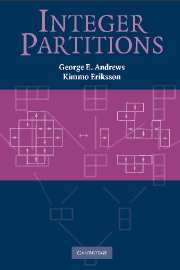Book contents
- Frontmatter
- Contents
- Preface
- 1 Introduction
- 2 Euler and beyond
- 3 Ferrers graphs
- 4 The Rogers-Ramanujan identities
- 5 Generating functions
- 6 Formulas for partition functions
- 7 Gaussian polynomials
- 8 Durfee squares
- 9 Euler refined
- 10 Plane partitions
- 11 Growing Ferrers boards
- 12 Musings
- A On the convergence of infinite series and products
- B References
- C Solutions and hints to selected exercises
- Index
11 - Growing Ferrers boards
Published online by Cambridge University Press: 05 June 2012
- Frontmatter
- Contents
- Preface
- 1 Introduction
- 2 Euler and beyond
- 3 Ferrers graphs
- 4 The Rogers-Ramanujan identities
- 5 Generating functions
- 6 Formulas for partition functions
- 7 Gaussian polynomials
- 8 Durfee squares
- 9 Euler refined
- 10 Plane partitions
- 11 Growing Ferrers boards
- 12 Musings
- A On the convergence of infinite series and products
- B References
- C Solutions and hints to selected exercises
- Index
Summary
In the past decade, there has been a surge of interest in random processes on combinatorial objects. In this chapter, we deal with recent developments in random domino tilings and random Ferrers boards.
Highlights of this chapter
The set of all integer partitions can be partially ordered according to the rule that one partition comes before another if the Ferrers board of the latter can be obtained by addition of squares to the Ferrers board of the former.
With this dynamic view of partitions growing by stepwise addition of squares, we obtain objects called standard tableaux by keeping track of the order in which the squares of a Ferrers board have been added.
With a simple rule for random growth of partitions, the shape of the rim of the Ferrers board tends to a quarter-circle. This growth process of partitions turns out to be closely related to random domino tilings of a shape called the Aztec diamond. The arctic circle theorem of Jockusch, Propp and Shor describes how four quarter-circles form a circular boundary (“the arctic circle”) between well-ordered (“frozen”) tiles in the corners and an inner chaos (“temperate zone”) in the middle.
Random partitions
How, for instance, can one generate random partitions of n so that all partitions are chosen with equal probability? For small n, say n = 4, it is easy.
- Type
- Chapter
- Information
- Integer Partitions , pp. 106 - 120Publisher: Cambridge University PressPrint publication year: 2004



